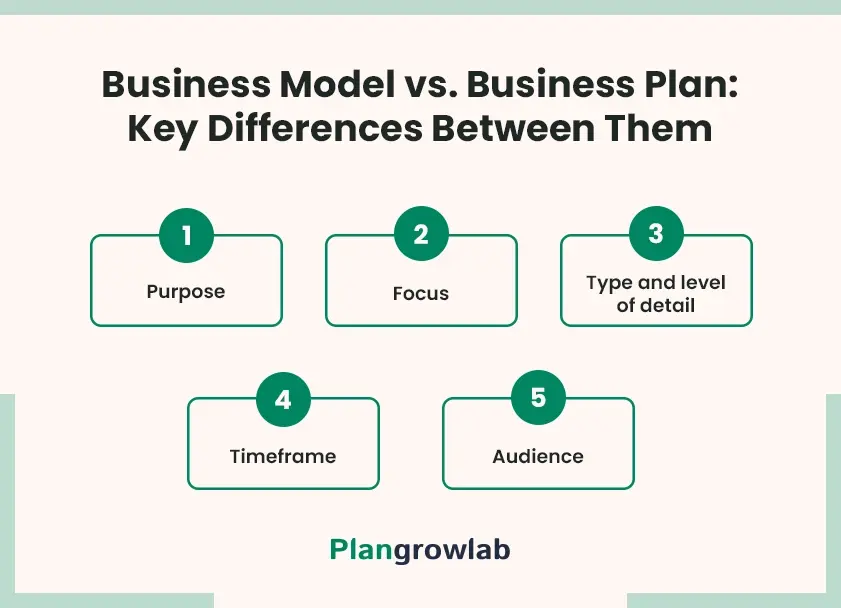If you’re considering starting a business, you’ll come across many terms that can create confusion when making important decisions. Some terms may seem similar but carry entirely different meanings in the business world.
One such pair is the business model and the business plan. While they might sound alike, they differ fundamentally in terms of purposes, components, factors, and even their target audience. Yet, a common myth persists that they’re the same.
Hence in this blog, we’ll explore business model vs business plan, which will help you uncover their key differences and learn how each uniquely drives your business in the right direction.
Let’s get started!
What is a business model?
A business model is a plan for generating profit by identifying the target market, outlining products or services, and estimating anticipated expenses. Think of it as the logic behind your business operations. It outlines the "what" and "how" of your business idea. For example:
The key components of a business model are:
- Value propositions - Why should customers choose you?
- Channels - How will you reach your customers?
- Customer segments - Who are you serving?
- Revenue streams - How will you earn money?
- Cost structure - What will your product or service cost to operate?
- Key resources - What are your essential operations?
- Key partnerships - Who can help you succeed?
What is a Business Plan?
A business plan is a written document that outlines your business’s goals, strategies, and the steps you’ll take to achieve them. It’s your roadmap for building a successful business, ensuring you achieve your goals smoothly and efficiently.
A business plan serves as a guide from the very beginning of your venture, helping you navigate the journey until your product or service enters the market.
A business plan remains a vital tool even after launch, offering strategies for sustaining and thriving in a competitive landscape. Overall, it provides clarity on the “who,” “when,” and “why” of your business operations.
The key components of a business plan are:
- Executive summary - A short overview of a complete business plan.
- Company description - Inform about your company, industry, and what makes you unique.
- Market analysis - Insights into your target market, competitors, and customer needs.
- Organization and management - The structure of your company and details about your leadership team.
- Products or services - A description of what you offer and how it solves a customer problem.
- Marketing and sales strategy - Plans for promoting your business and acquiring customers.
- Funding requirements - How much money you need and how it will be used.
Business model vs. business plan: Key Differences Between them
When it comes to understanding your business, people often confuse the business model with the business plan. Here are five key differences that will help you differentiate the two.

1) Purpose
A business model outlines how the business will generate profits. It focuses on the logic behind operations, including how you deliver value to customers and create revenue streams.
In contrast, a business plan is a detailed roadmap for executing the business model. It’s an action plan that turns your business idea into reality. A business plan encompasses operational strategies, financial projections, and marketing plans to achieve defined goals.
2) Focus
A business model focuses on how your business will generate revenue, whether through a subscription-based service, a retail store, or an online platform. Another key focus is creating a value proposition that addresses your target audience’s needs and sets your business apart from competitors.
A business plan, on the other hand, serves as a roadmap to turn your business idea into a successful reality. It delves into detailed operational and financial strategies, ensuring your business runs smoothly while preparing for economic, technological, or human challenges.
3) Type and level of detail
Typically, business models can be summarized in 1-2 pages. It includes components like value propositions, customer segments, and revenue streams. However, the level of detail may vary depending on the type of business model.
| Type of Business Model | Level of Detail Required | Estimated Number of Pages |
|---|---|---|
| Subscription-Based Model | Focus on customer retention strategies, pricing tiers, and recurring revenue streams. | 1-2 pages |
| Retail Store Model | Detail inventory management, store location strategy, and customer service operations. | 2-3 pages |
| Online Platform Model | Highlight user acquisition channels, platform monetization (e.g., ads, subscriptions), and scalability. | 2-3 pages |
| Franchise Model | Specify franchise agreements, brand consistency standards, and training/support systems. | 2-4 pages |
| On-Demand Services Model | Emphasize operational efficiency, user convenience, and scalable delivery logistics. | 1-2 pages |
Similarly, a business plan is not as concise as a business model, but its length varies depending on the business plan type. Generally, a business plan ranges from 10 to 15 pages.
| Business Plan Type | Level of Detail Required | Estimated Number of Pages |
|---|---|---|
| Traditional business plan | Extensive detail is needed, covering the executive summary to funding everything in detail. | 20-50 pages |
| Startup Business Plan | Focus on market research, funding requirements, and milestones for launch. | 15-25 pages |
| Operational Business Plan | Provide in-depth details on day-to-day processes, resource allocation, and team roles. | 20-40 pages |
| Strategic Business Plan | Focus on long-term goals, growth strategies, market analysis, and competitive advantage. | 10-30 pages |
| Feasibility Business Plan | Includes detailed market analysis, financial projections, and operational logistics. | 10-15 pages |
| Internal Business Plan | More concise and focused on operational needs or internal objectives, often less formal. | 5-15 pages |
4) Timeframe
A business model's timeframe begins at its inception. While it sets the foundation for early operations, it also aligns with a long-term vision. A well-structured business model provides valuable insights into how the company plans to sustain its operations over time.
A business plan evolves over time. It's a living document that guides your business through different stages, from launch to growth and beyond. Businesses also use this document to focus on short-term or medium-term achievements and to outline specific milestones.
5) Audience
A business model is primarily designed for internal use within the organization. It serves as a guiding framework that helps you and your team clearly understand how the business operates, generates revenue, and delivers value to customers.
The audience for a business model includes:
- Founders and entrepreneurs
- Internal team members
- Management and decision-makers
- Partners and collaborators
- Advisors and mentors
However, a business plan includes both internal and external stakeholders. It acts as a roadmap for anyone connected to the business, directly or indirectly. It’s often presented to:
- Investors and lenders
- Partners
- Advisor
- Management team
- Collaborators
- Internal teams
- Employees
- External teams
Conclusion
The distinction between a business model and a business plan clearly shows that both serve distinct purposes, concepts, and focuses. This blog has explored their definitions, components, and key differences.
So by now, you should better understand how to approach your business model and business plan to move your business forward effectively.
However, if you still need guidance or assistance in creating or refining your business model or drafting a comprehensive business plan, consulting an experienced business plan expert can be incredibly beneficial.
A professional business plan consultant can guide you in aligning your business model with your goals and transform it into a well-structured business plan ready for execution.
If you need help, consider booking a free 30-minute call to get started on the right track!
Frequently Asked Questions
What is the main difference between a business model and a business plan?
A business model focuses on how the business will generate revenue and deliver value to customers. It’s a high-level framework explaining the logic behind operations. In contrast, a business plan is a detailed roadmap outlining the steps to execute the business model, covering aspects like operations, financial planning, and marketing strategies.
Do I need both a business model and a business plan?
Yes, both are essential. The business model helps validate your idea and identify how the business will create value and earn revenue. The business plan builds on that foundation, providing the detailed strategies and actions needed to turn the business model into reality and ensure long-term success.
Which comes first, the business model or the business plan?
The business model comes first. It lays the groundwork by defining how the business will operate and generate profits. Once the business model is validated, the business plan is developed to create a detailed execution strategy.
How long should a business plan be compared to a business model?
A business model is typically concise, often summarized in 1-2 pages, such as using a business model canvas. A business plan, however, is more comprehensive, usually ranging from 10 to 30 pages, depending on the business type and purpose.


